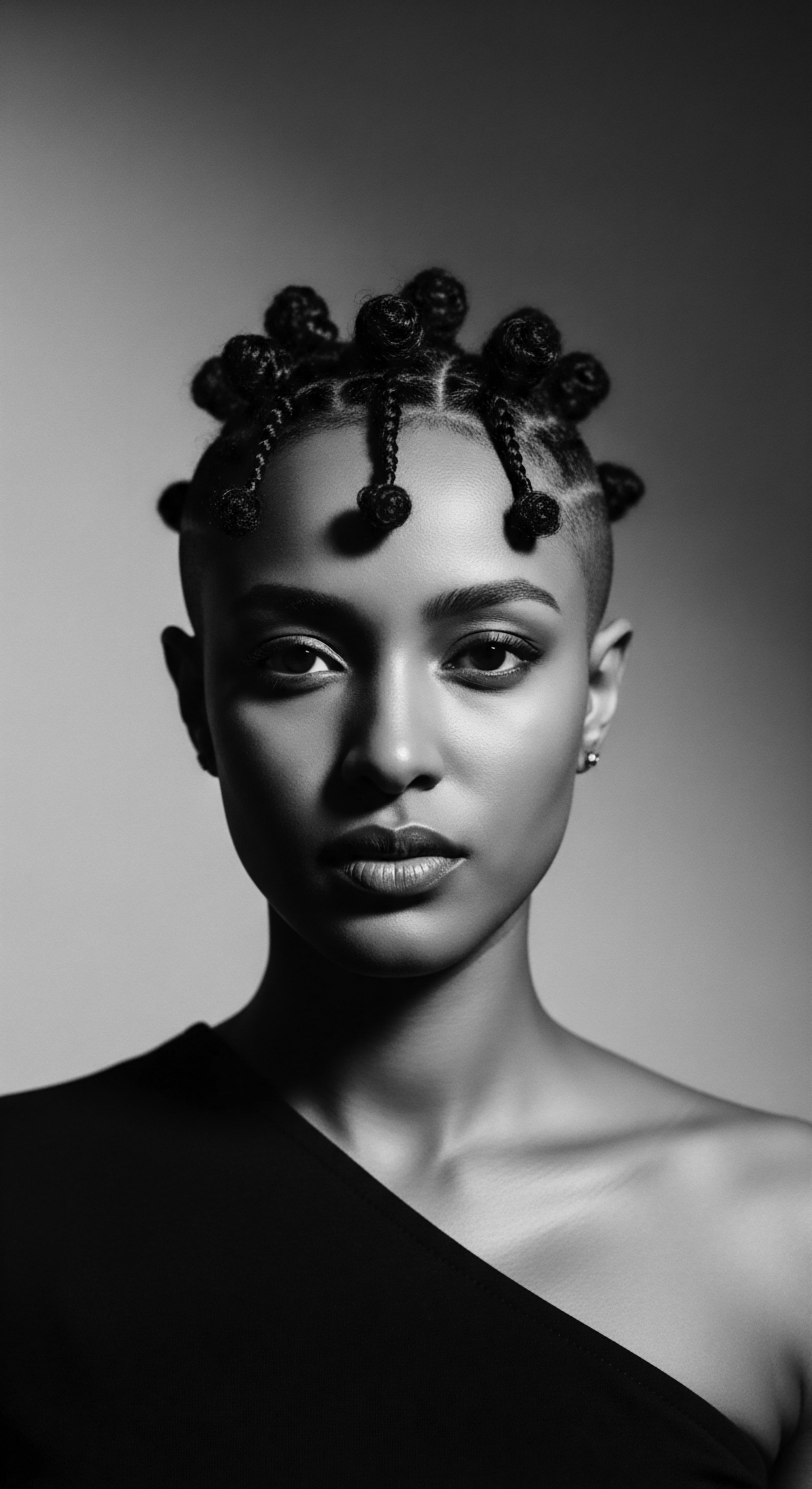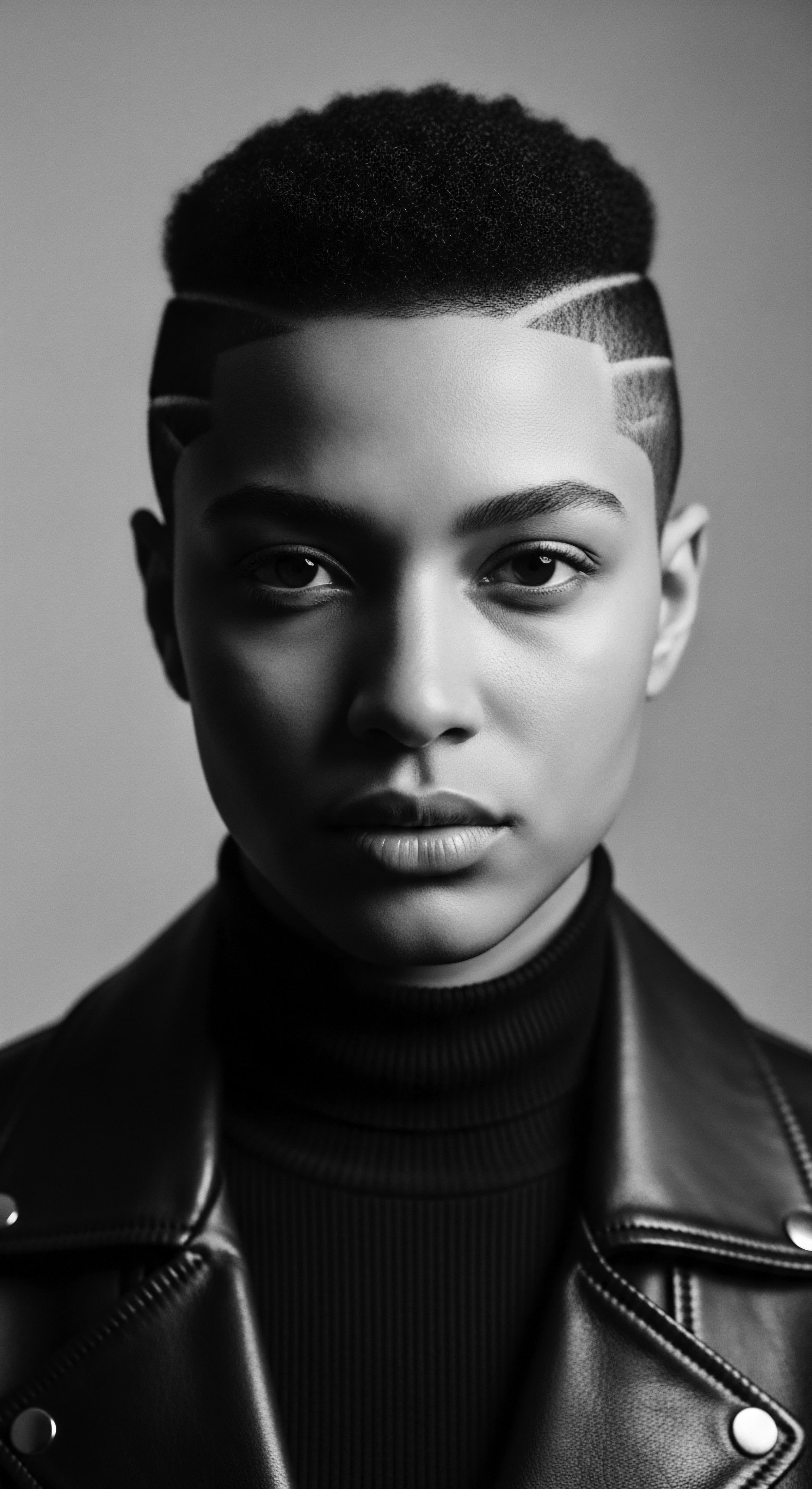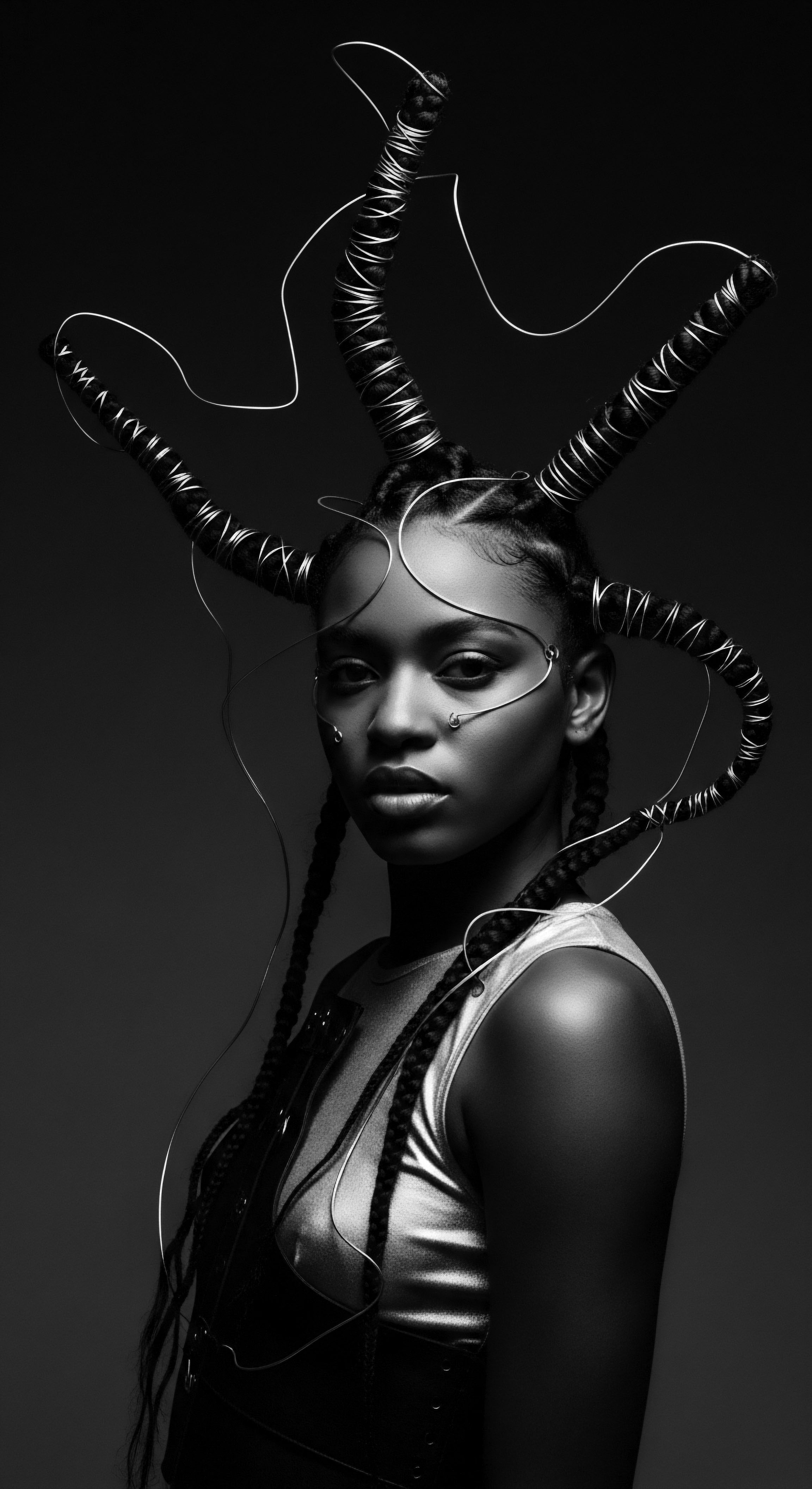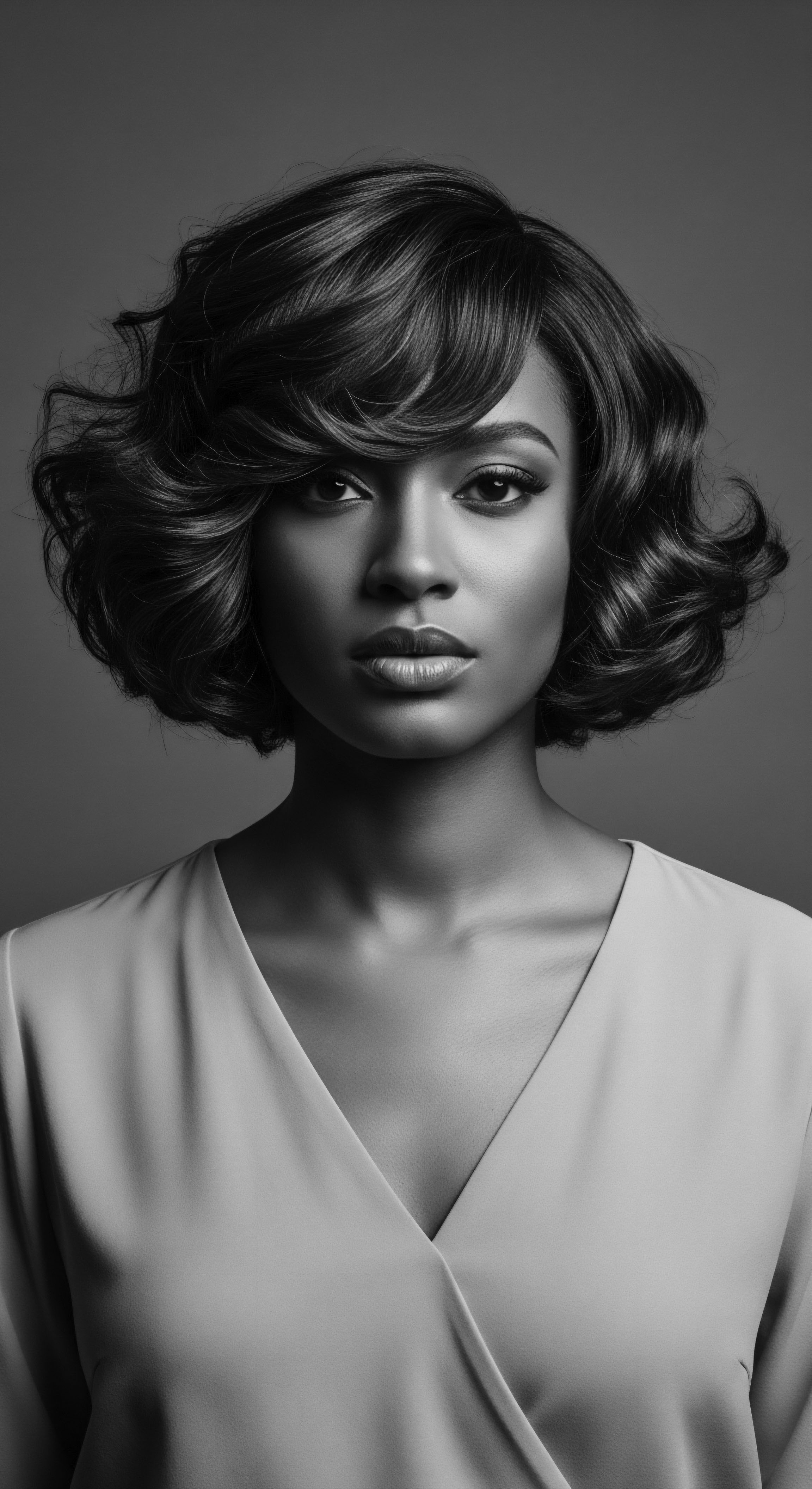
Roots
To stand on the threshold of our hair’s future, one must first feel the ground of its past beneath their feet. For those of us with textured hair, this past is not merely a chronicle of chemical treatments and styling trends. It is a profound, interwoven story, rich with the wisdom of ancestors, the resilience of communities, and the very biology that shaped our strands across continents and centuries.
The query, “Are ancient oils suitable for contemporary textured hair?”, invites us into this living archive, asking us to consider whether the gifts of ages past hold true efficacy for our hair today. It’s a question that asks us to look beyond the surface, beyond the gloss of marketing, to the ancestral science that underpins so much of what we seek in modern hair care.
Our hair, in its myriad coils, curls, and kinks, carries generations of memory. Each strand speaks of survival, creativity, and identity. The journey of these ancient oils, from their primal sources to the rituals of daily care, is a testament to human ingenuity and a deep connection with the natural world.
These botanical extracts were not simply beauty aids; they were vital components of health, community, and expression. We honor that continuum by truly understanding their properties and how they speak to the unique needs of textured hair.

The Textured Hair Codex ❉ Foundations From Ancestral Views
To truly grasp the place of ancient oils within our contemporary hair practices, one must first understand the fundamental architecture of textured hair itself. This understanding is not solely a modern scientific pursuit; it is a knowledge system built over millennia, passed down through the hands that braided, twisted, and cared for hair. The very structure of a strand, for textured hair, is distinct. Unlike straight hair, which typically possesses a round or oval cross-section, coily and curly strands often display an elliptical or flattened shape.
This structural variance leads to an uneven distribution of keratin along the hair shaft, causing the characteristic bends and twists. These natural bends create points where the hair shaft can be more vulnerable, and the cuticle, the protective outer layer, may not lie as flat. This inherent structural reality means textured hair often experiences greater moisture loss and can be more susceptible to dryness and breakage, a reality our ancestors instinctively understood.
Across various ancestral cultures, this understanding of hair’s innate qualities gave rise to specific care practices. In West African traditions, for example, the climate—often hot and dry—necessitated consistent moisture retention. Oils and butters were not just applied; they were massaged into the scalp and hair, often as part of intricate protective styles that preserved length and health.
The lexicon used to describe hair and its care was deeply woven into cultural narratives. Terms for different curl patterns, textures, and states of hair health were not abstract classifications but living descriptions, reflecting the intimate relationship between individuals and their hair within the community.
Ancestral hair wisdom recognized the unique structural needs of textured hair, leading to practices deeply intertwined with local botanical resources.
The very act of hair grooming, whether for the Mende people where well-groomed, oiled hair signifies societal adherence and beauty, or for the Akan-Fante of Ghana where hair defines status and personal taste, was a communal and spiritual undertaking. This collective understanding of hair’s inherent biology shaped routines designed to counteract environmental stressors and support the hair’s natural inclination towards dryness.

Do Hair Growth Cycles Respond to Ancient Remedies?
Hair growth cycles are universal biological processes, yet historical environments and nutritional factors significantly shaped how these cycles manifested and were supported. Our ancestors, lacking modern scientific instruments, observed and adapted. They understood that healthy hair originated from a healthy scalp. Many ancient oils, beyond simply coating the hair, were prized for their ability to nourish the scalp directly.
Castor oil, for instance, used in ancient Egypt, was believed to promote hair growth and add shine. Its contemporary use in promoting circulation to the scalp and nourishing follicles speaks to an enduring efficacy that scientific study now validates.
The concept of hair care as a holistic endeavor, where inner health reflects outer vitality, is deeply rooted in ancestral wellness philosophies. Ayurvedic practices from India, dating back thousands of years, emphasize balance between body, mind, and spirit as foundational to hair health. Oils infused with herbs such as amla, bhringraj, and neem were not simply applied topically; they were considered part of a larger system to strengthen hair follicles, prevent hair loss, and support overall hair health by balancing the body’s energies.
This deep historical perspective offers a powerful lens through which to view the suitability of ancient oils today. The question shifts from mere suitability to one of honoring and applying long-held wisdom.
| Aspect of Hair Hair Shape |
| Ancestral Understanding Recognized coils and bends needed specific care. |
| Modern Scientific Link Elliptical cross-section causes natural bends and vulnerability. |
| Aspect of Hair Moisture Retention |
| Ancestral Understanding Observed dryness; used oils/butters for moisture. |
| Modern Scientific Link Cuticle layer may be raised, leading to moisture loss. |
| Aspect of Hair Scalp Health |
| Ancestral Understanding Understood hair growth begins at the scalp; used infusions. |
| Modern Scientific Link Healthy scalp environment is critical for follicular activity. |
| Aspect of Hair The enduring suitability of ancient oils stems from their fundamental alignment with the inherent characteristics of textured hair. |
The inherent delicacy of textured hair, arising from its unique follicular structure, means it often requires particular attention to prevent dryness and breakage. African hair, with its distinct texture, demands deliberate and specific care. The historical removal of traditional hair cleansing methods during the period of enslavement, forcing reliance on animal fats and cooking oil, led to negative communal biases and further underscored the need for tailored, nourishing solutions. These historical realities amplify the value of understanding and reclaiming the ancestral knowledge surrounding hair care and the natural oils that once served as its cornerstone.

Ritual
The movement of hands, the rhythmic sound of a comb, the quiet absorption of botanical elixirs—these are not just isolated actions but the very fabric of ritual, passed down through time. For textured hair, the application of oils has always been more than a simple cosmetic step; it is a connection to a lineage of care, a tender dialogue between practitioner and strand. This deep-seated heritage suggests that ancient oils are not just suitable but, in many ways, intrinsically aligned with the unique needs and historical practices of textured hair. They whisper secrets of nourishment that modern formulations often try to replicate, sometimes with less reverence.
Consider the daily rhythms of life in traditional African societies, where elaborate hairstyles signified social status, identity, and even a connection to the spiritual realm. Oils and butters were central to maintaining these styles, providing both pliability and protection. The act of hair grooming was often a communal event, fostering connection and the intergenerational transmission of knowledge. This communal aspect, embedded in the very act of applying ancient oils, speaks to a holistic approach to wellness that extends beyond individual aesthetics.

The Protective Styling Encyclopedia ❉ Were Ancient Oils Its Foundation?
Protective styling for textured hair holds deep ancestral roots. Styles such as braids, twists, and locs were not merely aesthetic choices; they served vital functions in preserving hair length, preventing damage, and communicating cultural identity. Within these traditions, oils played a central role. They sealed in moisture, provided slip for easier detangling, and added a protective layer against environmental elements.
The use of shea butter, known as ‘nkuto’ in some Ghanaian languages, serves as a powerful illustration. For centuries, shea butter was used for “e v e r y t h i n g” from skin moisturizing to hair pomade. Women would warm metal combs, dip them in shea butter, and comb through their hair to soften and stretch it. This practice highlights how ancient materials facilitated styling techniques that are still relevant for textured hair today.
The effectiveness of these oils in supporting protective styles lies in their molecular composition. Oils like coconut oil, rich in lauric acid, and argan oil, abundant in fatty acids and vitamin E, have been scientifically shown to penetrate the hair shaft, reducing protein loss and improving elasticity. This scientific understanding validates the generations of anecdotal evidence and lived experience that made these oils cornerstones of ancestral hair care.

How Do Ancient Oils Support Natural Texture and Definition?
The allure of natural styling and curl definition is a powerful draw in contemporary textured hair care. Here, the suitability of ancient oils becomes particularly apparent. Unlike many synthetic products that can coat the hair with silicones, some of which may lead to buildup over time, traditional oils interact differently. They offer genuine nourishment and a hydrophobic barrier that helps prevent excessive water absorption, a common cause of frizz.
- Shea Butter ❉ Known as “African gold,” it has been used for hundreds, if not thousands, of years across the African continent. It provides deep hydration, protecting hair from sun and environmental damage. Its creamy texture makes it an excellent emollient for softening and managing coils.
- Argan Oil ❉ Derived from the argan tree indigenous to Morocco, this oil has been a beauty staple for centuries among Berber women. It is celebrated for its ability to hydrate, soften, and strengthen hair, reducing frizz and boosting shine, making it particularly beneficial for defining curls in textured hair.
- Castor Oil ❉ Used in ancient Egypt and the Caribbean, this viscous oil is praised for its moisturizing properties and its ability to help strengthen hair. Its thickness allows it to coat curls, providing definition and enhancing smoothness.
- Jojoba Oil ❉ While originating from indigenous American cultures, its functional similarities to the scalp’s natural sebum made it resonate with Black beauty traditions, providing exceptional moisture and scalp hydration.
These oils work by sealing the hair cuticle, creating a smoother surface that reflects light and feels soft. Some, like coconut oil, can even penetrate the cortex, the hair’s inner layer, to reduce protein loss and strengthen the strand from within. This dual action of surface protection and inner nourishment positions ancient oils as highly effective allies in achieving natural curl definition and overall hair health.
Traditional oils provide essential moisture and protection for textured hair, a testament to ancient wisdom anticipating modern needs.
The journey of these botanical wonders, from humble origins in specific ecosystems to their global recognition, speaks volumes. Batana oil, for example, derived from the American oil palm, has been traditionally used by the Miskito people of Honduras for centuries to nourish the scalp and improve hair texture. Its recent rise in popularity is a reflection of a wider societal movement seeking natural, time-tested remedies for hair care, a movement that naturally aligns with the heritage Roothea celebrates. These practices, though ancient, find their resonance in contemporary efforts to honor and care for textured hair with integrity.

Relay
The journey of textured hair care, from the ancestral hands that nurtured it to the contemporary laboratories that study its intricacies, is a continuous relay of knowledge. It is a story where ancient wisdom, often codified in communal rituals and botanical practices, passes the baton to modern scientific inquiry. The question of whether ancient oils are truly suitable for today’s textured hair then transforms into an inquiry about the enduring scientific validity and cultural resonance of these practices. We find that the deep understanding of hair’s elemental biology, once intuitive, is now often validated by molecular analysis, proving these ancient applications were far from arbitrary.
The cultural significance of hair for Black and mixed-race communities cannot be overstated. Prior to colonial influence, African hairstyles were markers of identity, social status, and spiritual connection. The intentional cutting of hair during the transatlantic slave trade was a brutal act designed to erase cultural identity and break spirits.
This history underscores why the reclamation and celebration of traditional hair care practices, including the use of ancient oils, represent not just a beauty choice, but an act of ancestral remembrance and self-affirmation. This historical context provides a deep backdrop to the scientific merits of ancient oils.

How Do Oils Interact With Textured Hair at a Microscopic Level?
Understanding the interaction of oils with hair requires a look beyond the visible strand, into its microscopic layers. Each hair strand possesses a cuticle, the outermost layer composed of overlapping scales. For textured hair, these cuticles may naturally be more raised, contributing to its tendency for dryness. Oils work in significant ways to address this.
- Cuticle Sealing ❉ When applied, many ancient oils coat the cuticle, helping to flatten its scales. This creates a smoother surface, which in turn minimizes moisture loss, reduces frizz, and promotes a more manageable texture.
- Lipid Replacement ❉ Hair naturally contains lipids that keep it pliable and smooth. Environmental factors, heat styling, and chemical treatments can strip these natural lipids. The right oils can replenish these compounds, restoring the hair’s natural feel.
- Protection Against Water Damage ❉ Oils form a hydrophobic barrier around the hair shaft. This barrier helps prevent excessive water absorption, which can cause the cuticle to swell and hair to become rough and frizzy.
- Protein Loss Prevention ❉ Scientific studies indicate that certain oils, particularly coconut oil, can penetrate the hair shaft to reduce protein loss during washing and styling. This is a crucial benefit, as protein loss contributes significantly to damage and roughness over time.
The chemical composition of these oils is key. Oils rich in saturated fatty acids, such as Coconut Oil, possess a molecular structure small enough to penetrate the hair shaft beyond the cuticle, reaching the cortex. This deep penetration allows for true internal strengthening.
Monounsaturated fats, found in oils like Olive Oil and Argan Oil, also demonstrate good penetration, enhancing softness and improving manageability. These scientific findings provide a compelling validation for the centuries of observational wisdom behind the use of these oils in textured hair care.

Are Ancient Oil Formulations Compatible With Modern Hair Needs?
The compatibility of ancient oil formulations with modern textured hair needs is a nuanced discussion, often revealing a harmony rather than a conflict. While modern products offer convenience and targeted solutions, they can sometimes introduce synthetic additives like silicones and sulfates, which may lead to buildup or strip hair of its natural oils. Ancient oils, by contrast, generally offer pure, unadulterated nourishment.
The enduring power of ancient oils for textured hair lies in their direct interaction with hair’s structure and the wisdom of generations.
An historical example that powerfully illustrates this enduring connection is the practice of hair oiling in India, deeply rooted in Ayurveda. This ancient system of medicine, dating back over 5,000 years, emphasizes a holistic balance for the body, mind, and spirit. Hair oiling is an integral part of this tradition, often beginning in childhood, where elders massage oil into the scalps of younger family members. This ritual, known as “sneha” in Sanskrit, meaning “to oil” or “to love,” transcends mere aesthetics, symbolizing care and bonding.
Studies on coconut oil, a staple in Ayurvedic hair care, have shown its ability to reduce protein loss by decreasing the tendency of the hair cuticle to swell, thereby minimizing combing damage. This rigorously backed data demonstrates how a long-standing ancestral practice, driven by intuitive understanding, finds scientific validation in the contemporary era. It underscores that the efficacy of these oils is not simply historical anecdote but a functional reality.
However, it is also important to consider hair porosity, a characteristic that describes hair’s ability to absorb and hold moisture. For those with low porosity hair, where cuticles are tightly packed, some heavier oils can form a barrier, inadvertently hindering water absorption. This does not mean ancient oils are unsuitable; rather, it suggests a need for informed application. Lighter oils like Jojoba Oil or specific application methods, such as using oils as a pre-shampoo treatment or with heat to open the cuticle, ensure optimal benefit.
The suitability of ancient oils for contemporary textured hair is not a matter of ‘either/or,’ but ‘how and why.’ They offer a foundational, potent base for care, often free from the complexities of synthetic compounds. Their efficacy is borne out not only by centuries of cultural practice but increasingly by modern scientific scrutiny, making them highly compatible with informed, contemporary regimens that prioritize deep nourishment and respect for hair’s natural inclinations. The relay of wisdom from past to present allows us to truly appreciate their lasting value.
| Oil Name Shea Butter |
| Primary Heritage West & Central Africa |
| Key Chemical Composition Vitamins A, E, F; fatty acids |
| Modern Application for Textured Hair Deep conditioning, scalp health, protective styling. |
| Oil Name Argan Oil |
| Primary Heritage Morocco (Berber communities) |
| Key Chemical Composition Antioxidants, Vitamin E, fatty acids |
| Modern Application for Textured Hair Frizz reduction, shine, curl definition, heat protection. |
| Oil Name Castor Oil |
| Primary Heritage Ancient Egypt, Caribbean, India |
| Key Chemical Composition Ricinoleic acid |
| Modern Application for Textured Hair Hair growth support, scalp nourishment, curl coating. |
| Oil Name Coconut Oil |
| Primary Heritage India (Ayurveda), Tropical Regions |
| Key Chemical Composition Lauric acid |
| Modern Application for Textured Hair Protein loss reduction, deep penetration, moisture sealing. |
| Oil Name These examples illustrate a consistent lineage of efficacy, where ancestral wisdom aligns with contemporary hair science for textured strands. |
The production of shea butter, for instance, has long been tied to women in Africa, earning it the moniker “women’s gold” as a source of income for millions. Archaeological evidence even suggests its use by ancient Egyptians as far back as 3,500 BC, where analysis of mummy hair revealed a stearic acid-rich material consistent with shea butter. This deep historical continuity, coupled with the butter’s proven benefits for textured hair, exemplifies how these ancient resources are not merely relics but living, breathing elements of hair care heritage.

Reflection
The query that initiated this exploration, “Are ancient oils suitable for contemporary textured hair?”, reveals itself not as a simple question of yes or no, but as an invitation to a deeper communion. It prompts us to consider how the enduring soul of a strand, rooted in ancestral knowledge and resilience, finds its continued expression in the present moment. The lineage of care, passed through generations, demonstrates that these botanical treasures are far more than mere ingredients; they are vessels of heritage, carrying within them the wisdom of adaptation, self-preservation, and profound self-acceptance.
The suitability of ancient oils for textured hair today is not a trend; it is a rediscovery, a thoughtful return to practices that understood the intrinsic nature of our coils and kinks long before modern science could articulate it. It is a harmonious blend where the historian speaks of hands that pressed shea nuts under an African sun, the wellness advocate sees the love in an Ayurvedic scalp massage, and the scientist confirms the molecular benefits of a well-chosen oil on a delicate cuticle. Our hair, an unbound helix of history and future, continues to benefit from these gifts from the earth. By honoring these ancestral practices, we do more than simply care for our hair; we participate in a living legacy, affirming our identity, and ensuring that the tender thread of textured hair heritage continues to shine with unparalleled radiance.

References
- Mende, M. (1894). The Native Races of South Africa ❉ A History of the Development of the Race. London ❉ Swann Sonnenschein & Company.
- Sieber, R. & Herreman, F. (2000). Hair in African Art and Culture. New York ❉ The Museum for African Art.
- Gallagher, R. D’Andrea, C. & MacEachern, S. (2023). The Archaeology of Shea Butter. Cambridge University Press.
- Tharps, L. (2001). Hair Story ❉ Untangling the Roots of Black Hair in America. St. Martin’s Press.
- Popenoe, R. (2004). Feeding Desire ❉ Fatness, Beauty, and Power Among the Azawagh Arabs of Niger. Routledge.
- Faria, C. (2018). Hair, Cosmetics, and Pageants ❉ Visualizing Women, Beauty, and Power in South Sudan. University of Wisconsin Press.
- Burke, T. (1996). Lifebuoy Men, Lux Women ❉ Comsumption, Gender, and Commodity Culture in Colonial Zimbabwe. Duke University Press.
- Charaka Samhita. (Ancient Indian Text).
- Ashtanga Hridaya. (Ancient Indian Text).
- Randle, G. (2015). The Black Hair Conspiracy ❉ Unraveling the Roots of Prejudice and Redefining Beauty. CreateSpace Independent Publishing Platform.
